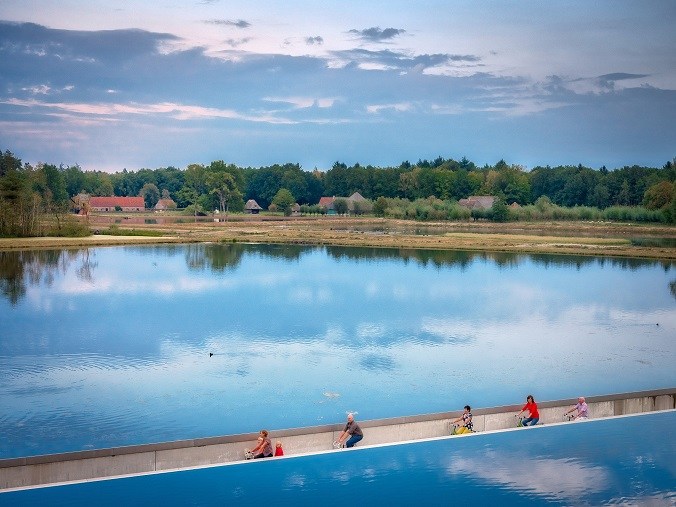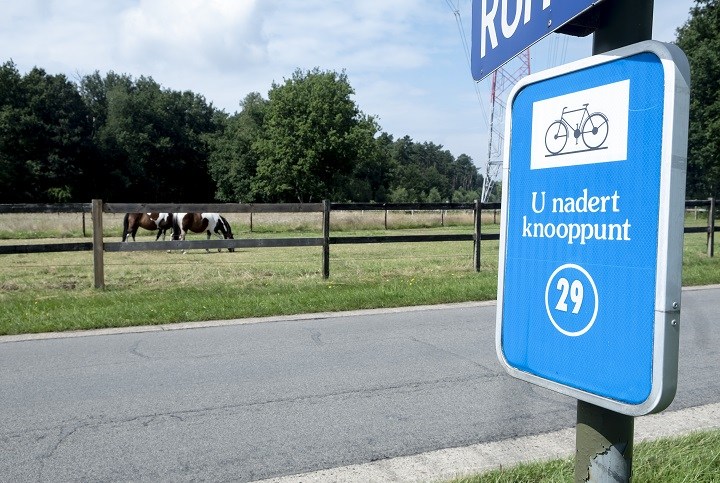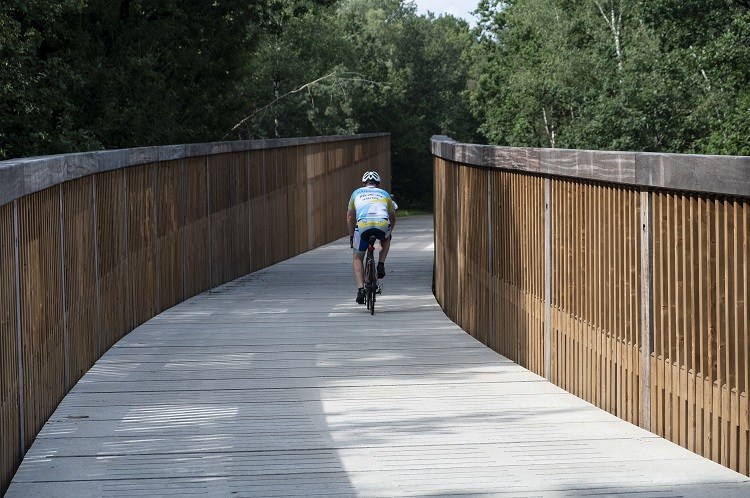Belgium has always had a special relationship with cycling, but a clever Flemish system of route nodes makes it easier than ever. As Daniela De Lorenzo reports, cycle tourism in Flanders is as easy as, well, riding a bike
Bicycle traffic jams have become frequent in the Hoge Kempen National Park since July as cyclists flock to ride over a newly built 300m wooden bridge raising gracefully over the heathland. The Cycling through the Heathland (Heide) bridge is the latest in a series of beautiful Flemish bike initiatives, making the region even more attractive to two-wheelers. And many cyclists reach the new hotspot with the help from a familiar friend: the fietsroutenetwerk, or bicycle route network. Cycling through the Heathland connects nodes 550 and 551, as it joins the extraordinary Flemish bike system.
For those who have never pedalled in Flanders, this vital bike system might sound odd. The fietsroutenetwerk or fietsknooppuntennetwerk (cycling node network) helps cyclists to ride routes through Flanders. All they need to do is follow the signs from one numbered node to the next. Each node is signposted with a rectangular blue sign: cyclists can put together their route on a map or the internet and note down the node numbers to take on the trip.
The concept has been around for half a century: it was designed in 1971 by the mining engineer Hugo Bollen, fed up with having to pull out a map at each crossroads to check where he was going. His scheme involved giving a number to each bicycle path across the region, creating a web of nodes, or points - ‘knooppunten’ in Dutch. However, it took until 1995 for the network to be rolled out in Limburg.
Cyclists planning their trips only have to check which knoppunten they have to cross from their starting points to their final destinations. At junctions, just like tombola scratch cards, the signs show a handful of numbers, where cyclists follow the directions of the next point on their lists, pointed by white arrows.
When it began, cyclists would write down their list of nodes and tape the strip of numbers on their crossbars. Many still follow this tradition. But with time, alternatives with GPS have appeared too.
Node planning
Vlaanderen Fietsland, is one of the online platforms providing the interactive biking map and a route planner app to select knoppunten and customize biking trips. Like a tour operator on your phone, it also proposes a selection of downloadable cycling routes, helping people discover special locations or race across gravelled routes.
Crunching down data, Vlaanderen Fietsland captures how Belgians use the fietknoppenpunten: in 2020, the website reached a community of more than one million users, with over 300,000 cycling routes downloaded. The lockdown measures and staycations brought many Belgians to dust off their bikes and pedal away the travel blues riding over 13 million kilometres.
The Flemish coast was the most popular cycling region, although the most cycled route on the network took people to the Arenberg Castle, close to Leuven. The total length of the network is around 13,000 km in Flanders, and each route has an average length of around 43 km. Some 98% of users come from Flanders, the remaining 2% come from Brussels, Wallonia and the Netherlands (only 0.1%).
The corona measures relaxation had a collateral effect: “We have 25% fewer visitors on our platform,” says Sven Nijs, from Vlaanderen Fietsland. But the crisis also had a positive impact on cycling attitudes. “We still have 150% more visits than in 2019,” he adds.
Building bike tourism
Flanders takes pride in its history of biking, bike racing and bike champions. Local authorities want the region to maintain its status as a cycling’s heartland, promote bike tourism and life on two wheels.
Over the years, Visit Limburg bet on pairing its stunning nature and the biking node network to attract more visitors to the region. The Cycling through the Heathland bridge and the renewed trail between junctions 550 and 551 is the latest effort to create unique biking experiences for bikers that started in 2016 with the scenic Cycling through Water in Bokrijk, allowing riders to cross a lake underwater.
In 2019, a second cycling project was inaugurated: Cycling through the Trees in Bosland, where cyclists can bike up to a wooden structure reaching the highest branches: "By carrying out or adding interventions to the recreational cycle route network at strategic locations, cyclists can interact with the landscape,” says Igor Philtjens, deputy and chairman of Visit Limburg.
Following a 13km bike ride through the knoppunten 250-30-29-534-251-252-550 from Hasselt, Cycling through the Heathland in Hoge Kempen now brings curious cyclists to the iconic bridge. The wooden structure celebrates its location and Limburg’s history: its walls are made of local pinewood, hinting at the region's mining past.
Families and amateur teams cycle the path that rises gradually to a height of 6.5m, giving them a breathtaking panorama of the national park: “We continue to invest and innovate in our cycle route network. In this way we put our province even stronger on the map,” says Philtjens. Visit Limburg’s choice turned successful as Limburg is now the most attractive bike destination for non-regional bike tourists.
Bike bonanzas
Flemish authorities keep renewing the portfolio of cycling experiences and activities. Between 2020 and 2021, eight new thematic cycling routes set on the network have been developed as part of the regional 'Touristic-recreational cycling in Flanders 2020-2025' project. Each route focuses on a central theme: the ‘Front route 14-18’ brings cyclists to navigate both sides of the German and Allied front lines during the First World War, while the ‘Meuse route’ follows the path of the river for 63 km along a string of historic villages and wide banks. They are also connected with the LF-Routes (Landelijke Fietsroutes, Dutch for countrywide cycling routes), the long-distance cycling routes in the Netherlands and Belgium.
The region is also scouting for bike enthusiasts from outside Belgium: the ambition is to profile Flanders as an ideal international destination for cycling tours. From September 18 to 26, the region will host the centenary edition of the UCI Road World Championships. The road races will bring all the big names in cycling to Flanders, attracting amateur riders too, who will be able to cycle the same routes. For over a week the four host cities will be on screen: the time trial will start on the beach in Knokke-Heist and end in Bruges, while the road races will start in Antwerp and finish in Leuven. When allied with its cycling node network, it shows that convincing cyclists to come to Flanders could be as easy as riding a bike.
By Daniela De Lorenzo




